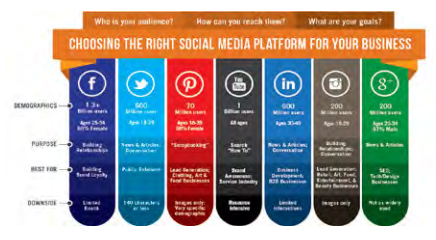16.10: Selecting the appropriate platform
- Page ID
- 42274
When choosing the most appropriate platform for your brand or business, you need to look at three key questions.
Who is your audience?
You need to define your target audience as much as possible, and research them well. Find out as much about them as possible. Include their digital habits and typical online behaviours in your research.
How can you reach them?
Once you know who your target audience is, you can analyse the demographics and psychographics of the typical users of the different platforms and choose the platform your target audience uses and spends the most time on.
Facebook and YouTube are popular choices because of their large user base and thus potential reach. However, more niche platforms such as Pinterest or LinkedIn may be better choices as your content will appeal to and resonate more to these refined target audiences possibly resulting in more engagement than on one of the larger platforms.
What are your goals?
Certain platforms lend themselves to certain business and marketing goals. Do you just want awareness? Or do you want to build relationships and establish yourself as an industry expert? Are you looking for hard sales and traffic? Each platform will meet different objectives, and it is important to choose one that is most appropriate to what you want to achieve.

As discussed earlier in the chapter, marketing on social media is no longer without costs. As more and more players enter the market, getting your content seen and noticed requires promoted posts, paid-for ads and targeted marketing. Even if having a channel, page or profile on a platform is free, creating content, especially videos, to put on the platform, costs money. It is important that the channel you post your content on provides the necessary return on investment.
With its large userbase and sophisticated targeting options Facebook provides the largest return on investment for most brands. With over 95% of brands sampled declaring a return from the platform. Snapchat with its expensive ads, smaller userbase, and limited ad control makes it a less attractive option. Only 2% of brands sampled declared any type of return on investment from Snapchat. These means that most marketers are putting their money on Facebook to see a return on their investment (Socialfresh, 2016).


